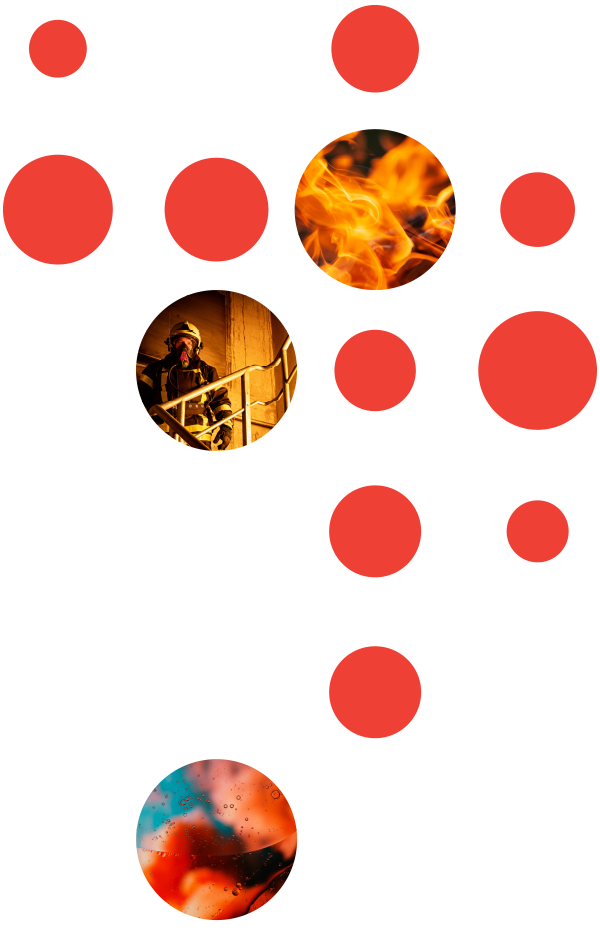Fight waste fires faster and reduce smoke and toxin release with biodegradable water additives
Information about waste fires
Causes: Waste fires can be ignited by a variety of factors, including the spontaneous combustion of flammable materials, the presence of ignition sources like discarded cigarettes, arson, or the decomposition of organic waste generating heat. Additionally, chemical reactions between different waste materials can contribute to the initiation of fires.
Environmental Impact: Waste fires release pollutants into the air, soil, and water. These pollutants can include toxic fumes, particulate matter, greenhouse gases, and hazardous chemicals. The environmental impact can be severe, affecting local ecosystems and contributing to air and water pollution.
Health Risks: The smoke and pollutants produced by waste fires can be harmful to human health, leading to respiratory problems, eye irritation, and other health issues, particularly for those living near the fire or downwind of the smoke plume.
Prevention: Preventing waste fires is essential. This includes proper waste management and disposal practices, separating flammable and hazardous materials, and reducing the risk of arson or unauthorised access to waste disposal sites.
Regulations and Guidelines: Many countries and regions have regulations and guidelines for the safe management and disposal of waste to reduce the risk of waste fires. Compliance with these regulations helps minimise the potential for such incidents.
Recycling and Waste Reduction: Reducing waste generation and increasing recycling can help decrease the amount of waste in landfills, reducing the risk of waste fires. Proper recycling and waste reduction practices can also have positive environmental and economic benefits.
Fires are extinguished up to 80% faster than water alone1
A one-stop-shop for all Class A fires (with testing pending for Class B).
Reduce water use and prevent environmental damage.
Independently tested in the UK and CE-certified for use worldwide.
BS ISO-9001 certification ongoing.
Types of waste fires
Waste fires can take various forms depending on the type of waste materials involved. Some common types of waste fires include:
Municipal Solid Waste Fires: These fires involve household and commercial waste, such as paper, cardboard, plastics, and organic materials. They can produce dense smoke and may contain hazardous substances.
Industrial Waste Fires: Industrial waste can include flammable chemicals, solvents, and other materials. Fires in industrial waste can be particularly challenging due to the presence of hazardous materials.
Hazardous Waste Fires: These involve waste materials that are known to be hazardous, such as chemicals, toxins, or materials that can explode when ignited.
Construction and Demolition Waste Fires: These fires can occur on construction or demolition sites and involve materials like wood, drywall, and other construction debris.
Landfill Fires: Landfills can sometimes catch fire due to the decomposition of organic waste, which can generate heat. These fires can be difficult to extinguish due to the vast amount of waste involved.
Tyre Fires: Tyre fires, whether at recycling facilities or illegal dumpsites, are challenging because they produce large amounts of smoke and can burn for an extended period.
Electrical Waste (E-Waste) Fires: E-waste, including old electronics and appliances, can catch fire due to electrical faults. These fires may emit toxic smoke.
Agricultural Waste Fires: Crop residues, like straw and hay, can catch fire, particularly after harvest seasons.
Biomedical Waste Fires: These fires involve medical waste, which can contain infectious or hazardous materials, making them dangerous to manage.
Waste Pile Fires: Piles of waste, regardless of the type, can spontaneously combust due to the heat generated by decomposition.
It’s essential to approach waste fires with caution, as they can be hazardous due to the materials involved and the potential for toxic smoke emissions. Proper training and equipment are necessary when dealing with waste fires, and it’s advisable to involve professional firefighters and relevant authorities to ensure safety and effective fire control.
How Marine 3 Fire Can Help.
Marine 3005 is a specific wetting agent designed for firefighting. Wetting agents, in general, have advantages when used on waste fires. These advantages include:
- Increased Penetration: Wetting agents can help water penetrate and saturate waste materials, making it easier to extinguish deep-seated fires and to create firebreaks.
- Reduced Surface Tension: Marine 3 Fire will lower the surface tension of water, which allows it to spread more evenly and cover a larger area, improving fire suppression.
- Enhanced Cooling: Marine 3 Fire aids a fire by cooling the fire and by promoting better heat absorption and dissipation, reducing the risk of reignition.
- Faster Knockdown: The mineral based agents can help control fires more quickly, reducing the potential for the fire to spread or escalate.
- Reduced time to suppress and extinguish waste fires: Marine 3 Fire reduces the time taken to suppress and extinguish a waste fire, releasing fire service resources in a quicker time.
- Improved Fire Control: Marine 3 Fire helps create a protective barrier that prevents the fire from reigniting or spreading.
- Capture CO2 gases: By applying Marine 3 Fire effectively in accordance with training and policy, the wetting agent can encapsulate the escaping CO2 gases thus reducing the CO2 output into the atmosphere. This can be seen in the tests that took place at the Fire Service College. The thick black smoke associated with tyre fires turns white within seconds as a result of the carbon capture.
It’s important to note that the effectiveness of a specific wetting agent like Marine 3005 can depend on various factors, including the type of waste materials, fire conditions, and application methods. Always follow the manufacturer’s recommendations and consult with experts or authorities in the field of waste firefighting.
Waste fires can be a significant challenge for waste management authorities and emergency responders, requiring a coordinated effort to control and mitigate their environmental and health impacts.
Contact us to discover more about Mosmart Fire Solutions and our unique Mosmart Marine3 Fire product.

